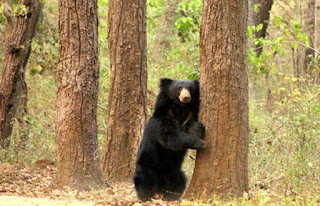THE BEAR
The bears, which include the large, modern land-dwelling carnivores, or flesh eaters, have several smaller relatives like the tree-dwelling raccoon.
The bears have heavy, long fur and stubby tails. The skeleton is massive. The limbs are strong and are furnished with powerful claws for digging and for fighting. The bear has shuffling gait. Its walk is plantigrade, that is, the sole of its foot is placed upon the ground, leaving a foot-print much like that of a human.
Bears are normally slow-moving animals, yet they can break into a lumbering gallop. The black bear can run at a speed of up to 40 km. an hour. The big brown bear has a peculiar pacing gait. In this, first the two legs of one side are raised and brought forward together, and then the two legs of the opposite side. The brown bear will sometimes gallop for about 2 km. straight up a steep slope without stopping to rest.
Bears let their presence be known by so-called bear trees. Often such trees stand conspicuously besides a bear trail. They are marked by smooth patches where a bear has rubbed itself or by jagged wounds where the bear has clawed at the bark. Strands of hair adhere to the bark and stick to the sap that oozes from the claw marks. Sometimes bears strip the bark from trees and scrape off the pulp that covers the wood, leaving tooth marks where the pulp has been removed.
Feeding signs also reveal the presence of bears. Ground squirrel burrows that have been dug up and the ant-hills that have been scooped out show where a bear has fed and on what it has preyed. Overturned and smashed logs and rolled over rocks are signs that a bear has been searching for ants and beetles.
A patch of uprooted vegetation may mean a bear has dug for roots. Bee trees are ripped apart for their contents of both honey and bee brood. Since bears cover leftover portions of food with debris, the discovery of such a cache signifies that a bear is active in the vicinity.



NICE BLOG THANKS KASHYANJI
ReplyDeletehttp://quickbookstech.supporthelpcontactnumber.co.uk/